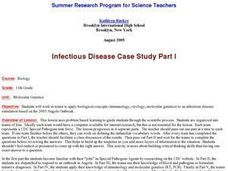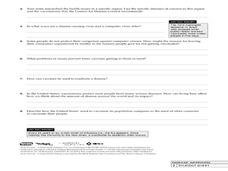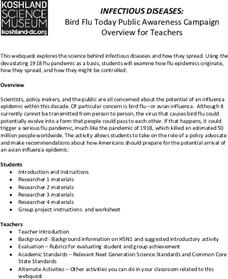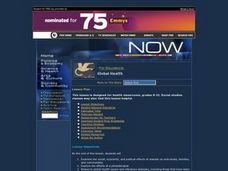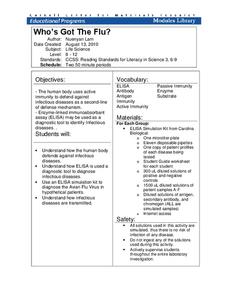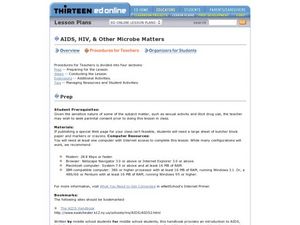Curated OER
Regents High School Examination: Living Environment 2003
The living environment, from the interior of a cell to the complex relationships among populations, are queried in this final examination. Learners look at air pollution maps, diagrams of cells, population graphs, and drawing of cells....
Curated OER
Infectious Diseases: Hepatitis B and Tuberculosis
Students discover the different sources of pathogens that cause diseases. For this health science lesson, students explore different ways to treat infections. They create a persuasive pamphlet on their position on vaccination.
Curated OER
A Miniscule Adversary: Combating Epidemics and Infectious Diseases in America
Tenth graders discover the spread of different diseases in US. In this health science lesson, 10th graders research the role of CDC and PHS in protecting the citizens. They explore documented cases of pandemics and their impact on...
Curated OER
STD & HIV/AIDS, Day 2: HIV/AIDS - Staying Safe
Decrease risky behavior and inform your secondary Special Ed class about AIDS/HIV. They talk about germs, AIDS, transmission, and staying safe. Developmentally disabled individuals need to be informed about safe sex and disease...
Curated OER
Body Defense and Disease
In this body defense and disease worksheet, students complete two multiple step questions about infectious diseases and how they are passed.
US National Library of Medicine
Science and Society: Preventing the Spread of Disease
Looking for a valuable resource on the spread of infectious diseases? Here is a lesson in which pupils simulate the spread of diseases and learn about how to prevent them from spreading. Class members read case studies about diseases,...
Curated OER
Deadly Diseases
Students consider the social, political, environmental, economic, medical and other considerations for why particular countries experience outbreaks of certain infectious diseases.
Curated OER
Infectious Disease Case Study Part I
Eleventh graders work together to complete a simulation on infectious diseases. They determine which concepts affect a disease more. They complete discussion questions as well.
Curated OER
Noncommunicable/Communicable Diseases
Students engage in an activity where they research noncommunicable and communicable diseases. Groups get together to research a particular disease then present to the class.
Center for Technology in Teaching and Learning
MedMyst: Animal Alert!
An outbreak of disease is affecting people in a distant region—it's time to get to work! Scholars take the role of scientists as they learn more about the illness, discover the possible causes, and find a way to prevent the further...
Curated OER
Disease Warriors
Students explore the importance of vaccines in fighting childhood disease. In this health lesson, students play a game to model how vaccines protect against the spread of infectious disease. Students play a tag based game in which the...
National Academy of Sciences
Infectious Diseases: Bird Flu Today
Understanding how viruses spread has never been more important. A well-designed WebQuest lesson has young scientists research viruses, how they spread, and how they are treated. They also consider the trends in common viruses in the world.
Curated OER
Communicable Diseases Word Puzzle
In this word puzzle, students identify twenty one words related to communicable diseases in a word puzzle. Examples include parasite, host, lymphocytes, and vaccines.
Curated OER
Global Health Issues
Examine global health issues and the philanthropic efforts of Bill Gates. Working in groups, your class will research selected diseases focusing on symptoms, transmission, and prevention. They also conclude by writing grant proposals to...
Center for Technology in Teaching and Learning
MedMyst Mission 1: Orientation at O.R.B.
A dozen years after a great plague wipes out the majority of Earth's civilization, a group of scientists joins together to fight infectious diseases. Scholars join the training mission and learn about viruses, bacteria, pathogens and...
Curated OER
Building a Pathway to Infection
Students experiment to discover how certain viruses spread through a population. They simulate the spread of a communicable disease by analyzing data to identify the person who was originally infected.
Curated OER
Webquest: Eradicating Guinea Worm Disease in Ghana
Students examine the impact of Guinea Worm Disease. In this world issues lesson, students take on the roles of Peace Corps Volunteers. Students will apply their knowledge of the Guinea worm life cycle to create a plan for eradicating the...
Curated OER
EMERGING DISEASES RESEARCH PROJECT
Tenth graders work in teams to gather and present historical as well as current information about an infectious disease. They complete student reports on a Disease Database form for all diseases selected. Students then share their...
Cornell University
Who’s Got The Flu?
Become an immunologist for the day. Scholars elicit the use of the enzyme-linked immunoabsorbent assay (ELISA) to diagnose an infectious disease. Through the process, they learn about the immune system response to infectious diseases.
Curated OER
HIV/AIDS & Other STDs, Day 1: Germs & Risk
Assist your secondary special education class for understanding risky behavior, hygiene, and STDs. The class discusses how germs spread, how people get sick, and what needs to be done to prevent the spread of communicable diseases. They...
Curated OER
The Nature of Disease
In this diseases worksheet, students will learn about infectious diseases including what causes a diseases and how they are spread. Students will also review symptoms of disease, patterns of diseases, and treating diseases. This...
Curated OER
Noncommunicable Diseases
In this noncommunicable diseases worksheet, students determine which diseases are not caused by pathogens and where a tumor is located. Then they describe a chronic disease that has a faulty immune system. Students also identify what...
Curated OER
AIDS, HIV and other Microbe Matters
This series of lessons contains sensitive material. Please review to ensure that the content is suitable for your class. It begins by discussing what microbes are. Scholars are then asked to review a few online resources and answer...
Baylor College
Making Copies of an HIV Particle
In the second of five lessons about HIV, discover the mechanisms that allow the HIV virus to replicate. Using the models that they created the day before, learners examine the parts of the virus particle. The lesson plan does not say...
Other popular searches
- Infectious Diseases
- Infectious Diseases Activity
- What Are Infectious Diseases
- Non Infectious Diseases
- Common Infectious Diseases
- Emerging Infectious Diseases
- Infectious Diseases Debate
- Genetic Infectious Diseases
- \"Non Infectious Diseases\









